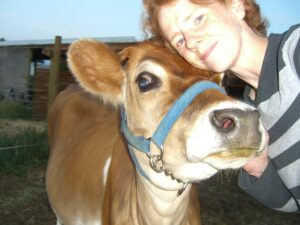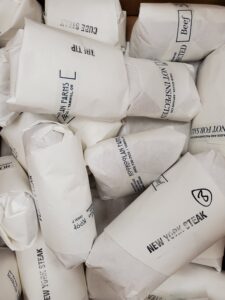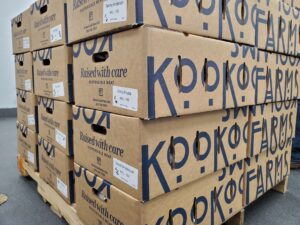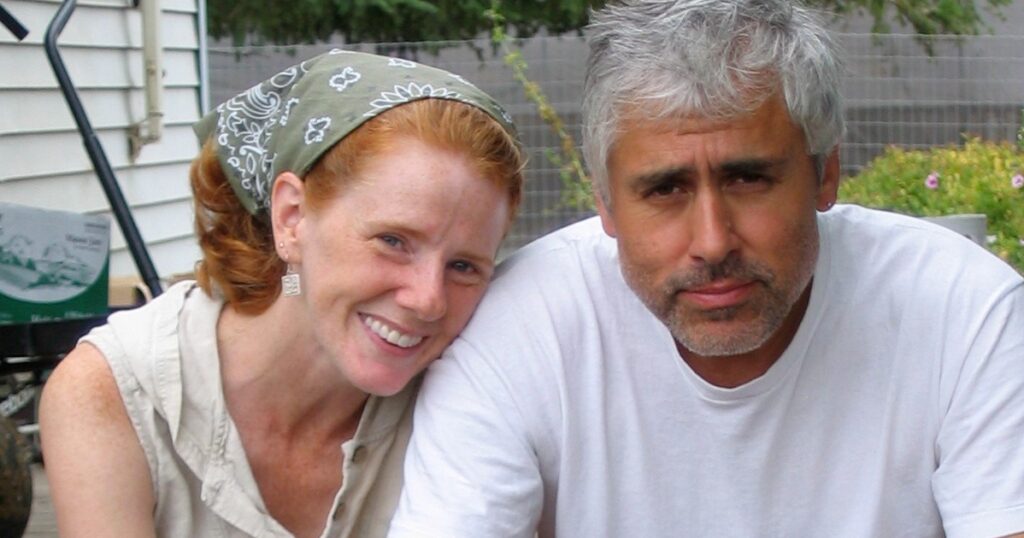Kookoolan Farms is a family farm in Yamhill, Oregon, run by husband-and-wife team Chrissie Manion Zaerpoor and Koorosh Zaerpoor. Located in the lush Willamette Valley less than an hour from downtown Portland, the farm raises grass-fed beef and lamb, as well as pastured chicken. You’ll find plenty of other goodies at the farmstore, including eggs, sustainably caught seafood, and mead. I sat down with Chrissie (virtually, thanks to covid) to learn more about Kookoolan and what being a small-scale farmer is all about.
Where does the name Kookoolan come from?
The short answer is that “Kookoolan” was a childhood nickname, a pet-name variation if you will, on founder/owner Koorosh Zaerpoor’s first name. It’s also something of a double entendre on the Irish/Gaelic legendary character CuChulainn (pronounced almost like “kookoolan”). There’s a much longer answer too, with the name having many layers of meanings to us.
What makes Kookoolan Farms unique?
Kookoolan farms makes buying locally and lovingly raised animal protein easy and accessible. Unlike other direct-to-consumer meat farms, Kookoolan offers beef shares as small as 1/16 of a beef. This  means that even apartment dwellers in the city can buy locally raised beef in a quantity that will fit into their refrigerator freezer.
means that even apartment dwellers in the city can buy locally raised beef in a quantity that will fit into their refrigerator freezer.
We don’t believe in a hard sell. Our goal is to create a community centered around ethically-raised and healthy food. We guarantee that “you will love your meat, or we will buy it back and eat it ourselves!” Kookoolan Farms is the only farm with such a guarantee. We also provide wild, sustainably caught, sushi-grade seafood — something not all farms can offer. We make surf and turf at home convenient and affordable!
There’s a lot to discover at the farm, including founder Chrissie’s world-class mead, a cozy farm cottage that can be rented on AirBnB, and spectacular views of the Cascade Mountains.
How did you get into farming?
 Like so many dramatic life changes, several things led us here. Koorosh always had a desire to become a farmer, but other ambitions led him to a physics degree and a career in engineering. Towards the end of that career, Koorosh endeavored to realize the agricultural dreams of his youth. Meanwhile, I was experiencing health issues that led me to look for well-raised, grass-fed meats. We were each vegetarians in the past, so holistic and healthy eating have always been important to us.
Like so many dramatic life changes, several things led us here. Koorosh always had a desire to become a farmer, but other ambitions led him to a physics degree and a career in engineering. Towards the end of that career, Koorosh endeavored to realize the agricultural dreams of his youth. Meanwhile, I was experiencing health issues that led me to look for well-raised, grass-fed meats. We were each vegetarians in the past, so holistic and healthy eating have always been important to us.
We discovered the benefits of ethical animal protein consumption and wanted to adopt that lifestyle. In the search for grass-fed, pasture-raised meats, the two of us found that no farms in the area were producing the type of product we were looking for. So, as the saying goes, if you want something done right … And so here we are!
What life lessons has farming taught you?
No one person can do everything. We all need each other, and every person you meet has important strengths and experiences that they bring to the table. In the early days, we tried to do it all ourselves. No employees, no partners — whatever needed to be done on the farm was done by either me or Koorosh. In the first three years of farming, we worked 1,000 days straight, 14 hours a day, too often even all- nighters!
Both of us were working responsible senior-level jobs at Intel while we were launching the farm. My son was four when we started the farm. On top of our work and family responsibilities, we were milking cows twice a day, feeding chickens, collecting and washing eggs, slaughtering chickens, selling at the farmers market, and delivering to restaurants in Portland.
Eventually it caught up to us. On April 1, 2008, I fainted and broke my jaw as I hit the ground. That was our wake-up call. If it takes a village just to raise a child, what would it take to run a farm?
That was the beginning of us opening our hearts and hands to the community. We developed a loose “co-op” model that created a support net of farmers and families in the Yamhill-Carlton area.
 What’s the most challenging part of running a small family farm?
What’s the most challenging part of running a small family farm?
We were workaholics at Intel, and we still struggle with work-life balance! We try to take care of our animals, employees, partners, and customers first. This means that sometimes our personal lives and problems come second while the farm takes priority. We’re happy to be bringing on a permanent full-time employee to help: “Farmer L.J.” is learning all of the customer service and farmstore operations, which will take some of the weight off our shoulders and open up some of our time for expansion projects around the farm.
What’s a typical workday look like for you?
I don’t think we’ve ever had two days that were exactly the same! One day we might be pruning trees or planting vegetables, the next day we may be building fences or painting the barn. We could be picking up orders from our meat processor in Hillsboro, or moving animals from one pasture to another. Alternatively, we could spend the bulk of our day doing taxes and accounting paperwork. There is no typical day, and we love it that way!
 When it comes to buying by the whole animal for the first time, what’s the most common question or concern your customers have?
When it comes to buying by the whole animal for the first time, what’s the most common question or concern your customers have?
Well for one thing, most people don’t buy a whole animal. In fact, for most first-time buyers, I would recommend a smaller share of the animal. Most people struggle visualizing how much freezer space they’ll need for a bulk beef purchase. That’s why I love There’s a Cow in My Freezer; it does such a great job of explaining space requirements and storage methods. People are generally curious about what cuts to expect and the freezer life of packaged beef. I love having your book as a resource for prospective customers. We give it away to anyone in our farmstore who is considering a bulk purchase of beef or lamb but isn’t quite ready to make the purchase, and we mail the book for free to anyone who asks for it.
What’s your favorite cut of meat and how do you like to prepare it?
Oh, I have lots of favorites! I love Julia Child’s recipe for boeuf bourguignon and make that at least once a month during the cold months, using either beef or lamb stew meat. I have several favorite recipes for cutlets and meatballs that I make using ground beef and ground lamb. When I want something a little fancier, I love making rack of lamb; when I want something a little more “everyday,” I love braised dishes using either lamb necks or shanks or beef cross-cut shanks. Beef flanken ribs might be my favorite “fast food” because it’s so easy to take them from freezer to table in 15 minutes!
2020 has been a crazy year. How has the pandemic affected the farm?
Gosh, where do I start? The pandemic has made people more conscientious about food security. This means we have experienced a glut of new customers and orders. We realize it is a tremendous privilege to be able to say this while other businesses are struggling, but it does come with its own set of problems.
First, the flood of new orders meant that our existing customers were sometimes getting shut out of beef availability. Feeling a responsibility to our existing customers, we implemented our new Meat Club model. This allowed us to guarantee availability for our existing customers and make room for all the new customers.
We were not the only producer that saw an increase in customers. This meant that our processor was also experiencing higher demand. This means that we now have to schedule processing dates 18 months in advance. The growth cycle of beef includes a 9-month pregnancy, 8–10 weeks or nursing, and finally 18–24 months on pasture before being ready for slaughter. This means we have to predict customer orders a good three and a half years in advance!
Our orders tripled at the peak of the summer. This dramatic increase meant that we had to redesign our ordering and tracking system from the ground up. This increase also meant that we were outgrowing the freezer space in out farmstore. Chest freezers, as your readers likely know, are not widely available this year, so we decided to buy a commercial walk-in freezer. This posed a new problem, as our current farmstore did not have the space or the electrical capacity for a walk-in, so we decided to start construction on a new, larger farmstore. This meant architectural work, permits, land use applications, and all the other associated costs that come with new construction.
 The new freezer system also means that our old way of storing customer orders in IKEA bags was now defunct. You can’t stack IKEA bags very well in a walk-in! So we had to make the switch to boxes, which snowballed into a whole redesign of our packaging and storing methods.
The new freezer system also means that our old way of storing customer orders in IKEA bags was now defunct. You can’t stack IKEA bags very well in a walk-in! So we had to make the switch to boxes, which snowballed into a whole redesign of our packaging and storing methods.
Just like the initial days of the farm, Koorosh and I have been working 15- to 18-hour days to keep up with the workload this year. Of course, like everyone, we’ve been mostly isolated from friends and family and have been doing all the work alone. However, the growth has allowed us to hire a third full-time farmer for the first time.
What’s on the horizon for Kookoolan Farms in 2021?
There are some great things on the horizon! Our new farmstore will have a larger capacity, more retail items from various local vendors and artisans, and the included benefit of having a full-time staff member in L.J. The new farmstore will also include an outdoor kitchen and picnic area, where we will begin to host wine tastings and other events this summer! Having a third person on staff will also allow us to increase production capacity for our famous pasture-raised chickens and catch up on our years-long waitlist!
We’re excited to continue to grow and offer our community a resource for ethically farmed food, as well as becoming a fun location to visit in the Yamhill-Carlton area.
Check out Kookoolan’s Facebook page for farm updates, interesting food news, tasty recipes, and more. If you’re in the area, be sure to stop by the farm to check out everything it has to offer and meet the people who have poured their time and passion into this amazing place. As a bonus, anyone who visits the farm can request a free copy of the book — just ask!
